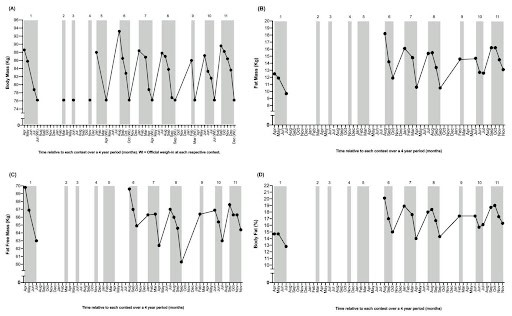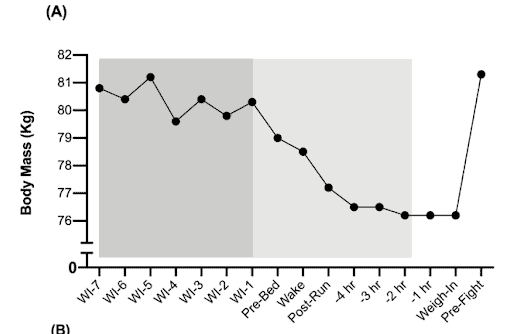Weight cutting in combat sports: What is it and how can you minimise the risks?
The majority of combat sport athletes will go through a period of short-term weight loss prior to a fight. Why do they endure this, and can it be done safely?
Weight cutting: Why do some athletes endure it?
Following eight weeks of strict, tightly controlled nutritional intake, combined with tens of thousands of pounding steps during the cold morning runs, you find yourself at the start of fight week. This is the week elite fighters should love – the build-up, the electric energy around the city and the media attention ramping up as they come ever closer to strapping their wrists and striding towards the ring with their chosen anthem exploding out of the stadium speakers.
In the ring, every heartbeat grows quicker and louder as the fighters stare across at their opponent – the aim of the next 36 minutes is to hit them with devastating force. This is combat sports!
Although it is the fight that occurs inside the ring that decides who has their hand raised at the final bell, there is a catalogue of considerations, or worse, catastrophes, that each fighter must navigate beforehand to ensure preparedness for battle. The most common of which is weight cutting.
You might find yourself asking: “do combat sport athletes really need to cut weight? Why can’t they just fight at the weight they walk around at every day?” Well, you’d think this is the most sensible approach, yet the majority of combat sport athletes will go through a period of short-term weight loss prior to a fight. Some will even put their body, mind and soul through hell and lose a dangerous 10kg in 24 hours!
Weight cutting done incorrectly can result in serious consequences, and in some devastating situations, even death. So why do they do it? In my recent Coach Academy mini-course, I discuss this in more detail, but for now, let’s explore some of the main points around weight cutting and explore a couple of strategies to maximise the benefits while minimising associated risks.
Before we really dive in … a warning
Please be aware: if you or your athlete are going to make weight for competition, make sure you safely follow evidence-based guidelines. Even better, work with a professional nutritionist/dietician to support you through the process.

The weight cut, and the 3 Ts of nutrition
In very simple terms, weight cutting is the process of decreasing body weight during an acute period of time. However, prior to any weight cut (the final seven days prior to competition) starting, the manipulation of body composition is best done gradually over time. Essentially, before the final week of training camp and before any acute weight loss occurs, the goal is to reduce fat mass while maintaining or even gaining lean mass (muscle). Basically, if you are carrying extra fat mass, this is the time to get rid of it and ‘lean out’.
For professional boxers, body composition changes substantially over time. Some hot-off-the-press data of mine (see figure 1 below) shows how a boxer’s body composition fluctuates over time, but also how important it is to have a fighter at their ‘optimal’ body composition when entering the final seven days prior to weight cut.
A key concept I discuss throughout the mini-course and in many podcasts is the 3 T’s of nutrition – Timing, Type and Total. Put simply, these refer to the time of day you are eating, the type of food or fluid you are consuming and the total amount of both. If you and your combat sport athlete can understand how the 3 T’s work together, like three cogs in a very well-oiled machine, then you will be in a great place to safely improve body composition prior to any acute weight cutting. Better still, this 3 T’s model also applies to the training that combat sport athletes perform. So, again, what time of day are you exercising? What type of exercise are you performing? And for what duration?
If you dovetail these two models together, on a practical level, you will be implementing the framework: “fuelling for the work required.” In short, this is when pre-planned nutritional intake is aligned to the training demands of your day to elicit both the correct training adaptations and body composition targets. Even Premier League clubs adopt this framework for professional football players.
Prior to competition, combat sport athletes have their body mass verified at the official ‘weigh in’ to ensure they meet the weight requirements of their competitive division. Within combat sports, this is known as ‘making the weight’. The actual time duration between the weigh-in and stepping into the ring for competition differs between sports. However, a recovery period of at least three and up to 24 hours exists among the Olympic combat sports.
If done correctly, the weight cut should be a planned, prepared and easy process to perform, which results in a well-nourished, well-hydrated and happy athlete in the ring. If implemented poorly, with minimal evidence behind it, or by individuals who are not registered nutritionists/dieticians, the athlete can struggle and experience distress. Essentially, get the recovery from ‘making the weight’ wrong, and it could result in a shocking performance in the ring and an easy fight for your opponent. Even professional boxers get this wrong at times. We just have to turn our attention to Kid Galahad having to take his underwear off to make the weight at his official weigh in for his fight against Eddie Hearns.
 FIGURE 1. Body mass, fat mass, fat-free mass, and body fat percentage changes in a professional boxer over time during 11 contests.
FIGURE 1. Body mass, fat mass, fat-free mass, and body fat percentage changes in a professional boxer over time during 11 contests.
What are the benefits of cutting weight for a fight?
Many combat sport athletes believe cutting weight before a fight results in advantages over their opponent when in the ring. Mainly, the ability to rebound in weight, enter the competition heavier than their opponent and use this to their advantage in clinches or up against the ropes. Interestingly, studies exploring how weight manipulation strategies affect competitive outcomes in boxing are inconclusive.
With this in mind, it really does depend on what the fighter prefers to do, what has been practised in training and what works best. Irrespectively, ensuring individual strategies are implemented with each fighter is key, rather than using a cookie-cutter approach for all.
In my experience, making sure your fighter is well-nourished and well-hydrated with plenty of room for an acute weight loss to occur should ensure they enjoy the entire process. They will also enjoy the weight regained, as they will replace fluids lost and increase their energy ready for fight. Always remember, a happy fighter is a dangerous fighter. The opposite of this is a fighter who enters the final week of acute weight loss dehydrated and having under-eaten – they will already be struggling and, in most cases, should not put their body through the extra stress of trying to lose weight. This can be dangerous and should be reconsidered.
How much weight is too much weight to cut?
This is the golden question, and it is very difficult to put a definite figure on it. Firstly, where possible, you should always assess body competition using standardised measurement methods and regularly and correctly collect body weight. This will give you a far greater insight as to how much body weight needs to be lost in the final few days.
In the week prior to weigh-in, the current literature shows fighters commonly lose mass which is either greater than or equal to 10% of their own body weight. For example, some fighters who weigh in at 70kg might lose 7kg in the final week before weigh-in. However, as mentioned, this is very individual-specific, and while there is no single ‘ideal’ acute weight loss target, research suggests that under some conditions, a loss of 5–8% body mass may be possible, with an acceptably small impact on health and performance. Again, the starting point prior to acute weight loss should represent body mass associated with a fully hydrated, well-nourished state, offering plenty of opportunity for meaningful manipulation of gut content and body water.
It is widely accepted within the industry and literature that decreases in body mass greater than 10% in the final few days prior to competition can be dangerous and should not be attempted. For those of you who would like to view what it looks like to make the weight this way, I would draw your attention to these two video clips:
Weight cut: Can I lose 10% of my body weight overnight?
Aspen Ladd struggles to make the weight
Rocky’s Run – a snapshot of a pro
In my recent publication, I present data showing an approximate 5kg decrease in body mass during the final five-day period prior to the official weigh-in (Figure 2).
 Figure 2. Changes in body mass during the seven days before the official weigh in, weigh in day and contest day.
Figure 2. Changes in body mass during the seven days before the official weigh in, weigh in day and contest day.
This was typical of the way professional boxer Rocky Fielding made weight for the 11 camps that we worked together over the past four to five years.
You can see how Rocky was still above 80kg the day before the weigh-in and lost between 3-4 g in the final 24 hours; this represented about 5% of his total body weight.
READ MORE: THE SEVERE, DETRIMENTAL EFFECTS OF MAKING WEIGHT THE WRONG WAY
In particular, you can see across five contests, his average weight loss achieved via acute weight loss strategies during the final seven days was 3.7kg and represented 4.7% of his body weight (Table 1 below).
How to minimise the risks of cutting weight
There are many ways in which body mass can be reduced during the final few days and hours prior to making the weight. If done correctly, there should not be any real risk involved in the cutting of weight. Indeed, a combination of the following methods can all work together to see a drop of between 1-8% of body weight prior to weigh-in. If you would like to read about this in more detail, then I recommend this fantastic paper by Reid Reale.
Gut content manipulation
Body water change
Sweating methods
Utilising the above methods can aid combat sport athletes to make weight safer, providing they enter the start of fight week in a well-nourished and well-hydrated state. The following strategy is just one way they could be implemented and is highly dependent on the athlete’s body mass at the start of fight week before they begin making weight. The below is a guide based on an athlete who is 3-4kg over the weigh-in weight.
Day 5
Regular fibre intake, regular sodium intake, normal fluid intake, normal carbohydrate intake
Day 4
Regular fibre intake, regular sodium intake, normal fluid intake, normal carbohydrate intake
Day 3
Regular fibre intake, regular sodium intake, normal fluid intake, normal carbohydrate intake
Day 2
Low fibre intake, low sodium intake, normal fluid intake, moderate carbohydrate intake
Day 1
Low fibre intake, low sodium intake, moderate fluid intake during the day, low fluid intake in the evening, low carbohydrate intake
Weigh-in day
Low fibre intake, low sodium intake, low fluid intake, check weight and sweat as needed
Want to know more?
If you want to know in more detail how to implement a correct weight cut during the final few days before a fight and what this looks like with food and fluid examples, then I would recommend you check out my mini-course.
Before we go – stop what you’re doing and get professional advice!
As a general rule of thumb for weight-cutting, ask yourself the question: “Is my athlete well hydrated, well-nourished and has less than 10% body weight to drop in the final 5-7 days?” If the answer is yes, then you are in a good place to enter the final week of acute weight loss and making the weight. If your athlete is already dehydrated and has dropped their energy intake, I would seriously reconsider progressing with the weight cut and would personally advise against it.
If you do have an athlete who is in a great starting position for the weight cut but then experiences headaches, poor sleep, and generally feels unwell, then again, I would stop the weight cut and consider pulling them out of the upcoming fight.
It is important we look after the health and wellbeing of our fighters and are confident they are in a healthy position to go ahead and perform in the ring.




